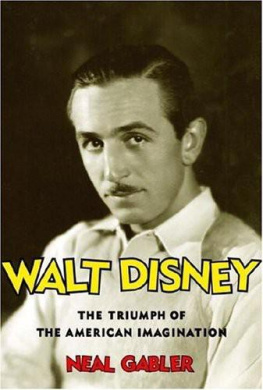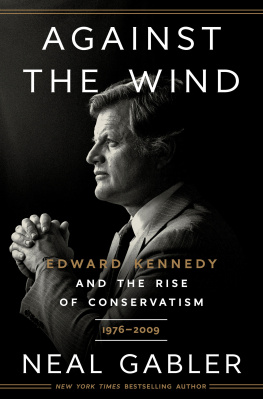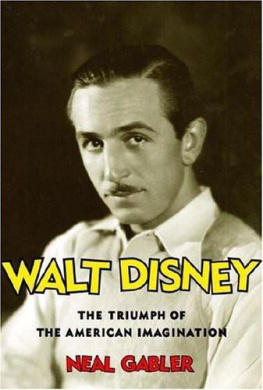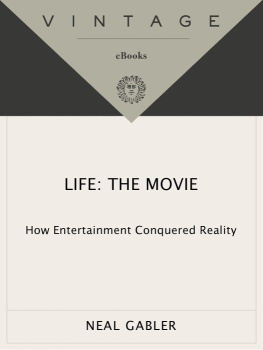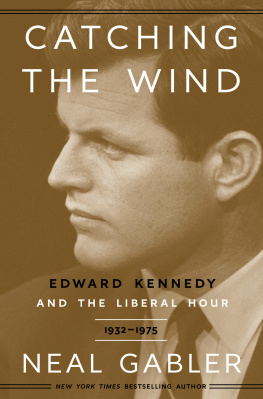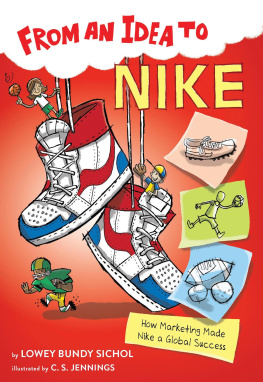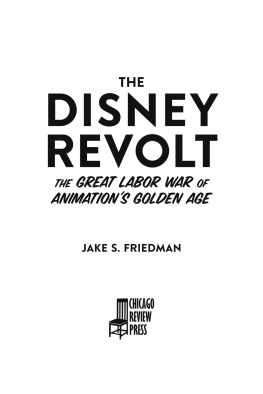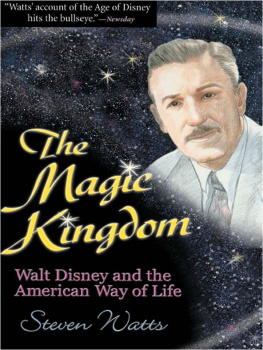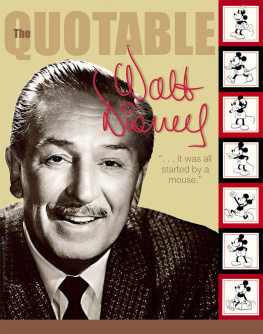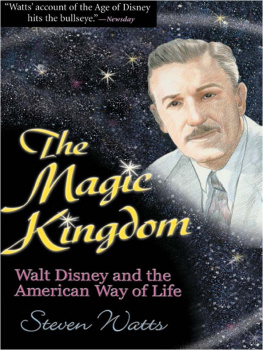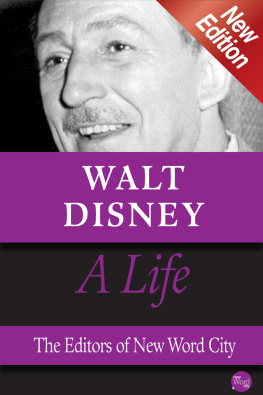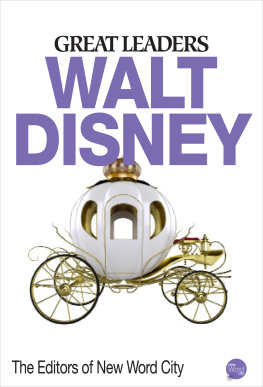ACKNOWLEDGMENTS
When one works on a project as big as this one for as many years as it has taken me to accomplish it, one accumulates many debts along the way, but I have one major creditor: Howard Green. Among scholars, the Walt Disney Company has gained the unenviable reputation of being an impregnable corporate fortress, about as forthcoming as the old Soviet Kremlin. No one gains full access, I was warned by numerous individuals who had tried, unless one is serving the companys agenda. Those people didnt account for Howard Green. Howard Green is the longtime vice-president for studio communications at the Disney company, though the crisp austerity of that title is misleading. Howard is no button-down bureaucrat. He is an enthusiast, a historian, an astute critic, a facilitator, and a good and generous friendsomeone who would have fit comfortably into the old, informal Hyperion enclave. His friendship has been one of the great rewards of my writing this book. When I first met Howard at the studio years ago at the inception of this project, I was braced for a maze of restrictions and a pile of provisos, including the proviso that I write approvingly of Walt Disney. Instead, I got a simple injunction: Write a serious book. I have tried to do so, but I couldnt have done so without the assistance of Howard, who opened the extensive Disney archives to me and introduced me to Disney animators, Disney scholars, old Disney employees, and acquaintances of Walt. It should be noted that having done all this, Howard did not require me to submit the manuscript to the studio for approval, and I havent. I received cooperation. I did not seek nor did I receive a company imprimatur.
Another individual who deserves special praise is Roy E. Disney, Roy O. Disneys son and Walt Disneys nephew. I was told that Roy E. was instrumental in facilitating studio cooperation for this book. At the same time, he never attempted to influence what I was writing.
Having been loosed in the Disney Archives, where I would spend thousands upon thousands of hours working my way through Walt Disneys correspondence and reading tens of thousands of other documents as well as watching Disney films and listening to Disney recordings, I was aided and abetted by three other extraordinary individuals whom I am now privileged to call friends. Dave Smith founded the archives in 1971 and has headed them ever since. In the Disney community Dave is a legendthe primary fount of Disney information. He was never less than generous in sharing that information with me, in answering all questions, large and small, and in ferreting out any material that I requested and even some that I didnt know enough about to request. The archives manager, Robert Tieman, is also a published Disney authority. Robert, a self-professed curmudgeon, once took umbrage at an article that described him as cheery, so he will no doubt be offended when I say how much I appreciated his willingness to answer the numerous questions with which I pelted him daily, his forays to the annex to find material that was not readily available, anddare I say itthe dry good humor with which he tolerated me even after years of my pestering him for Disney arcana. Roberts drollery leavened those long ten-hour days in the archives. Last but by no means least is Rebecca Cline, the assistant archivist. Rebecca not only answered questions, fetched material, Xeroxed documents, assisted my photo research, and took me on a tour of the studio, including Walts office, she also patiently listened whenever I discovered what I thought was some golden nugget of information and listened even more patiently as I expatiated on some new theory of Walt that I was formulating. Just as Roberts drollery helped me through those long lunchless days, so did Beckys kindness and unfailing good nature. One couldnt ask for a better companion or a more decent human being. In addition to everything else they did, Dave, Robert, and Rebecca all read the manuscript and provided comments that made this a better book than it would otherwise have been. Thanks are due as well to Brian Hoffman of the archives, and Shelly Graham at the Disney Photo Library, who assisted in the photo research and scanned the images, and Margaret Adamic, who provided legal clearances.
I also received encouragement and assistance from the community of Disney scholarsand it is a community. Virtually all of them offered to help, welcoming me into their ranks and sharing their interviews, their documents, their contacts, and their insights. I owe thanks to Michael Danley, Katherine and Richard Greene, J. B. Kaufman, Jeff Kurtti, Les Perkins, Alex Rannie, Rick Shale, and above all Paul F. Anderson, the editor and publisher of the indispensable Disney journal Persistence of Vision, who not only provided material from his own extensive archives and supplied his informed perspectives on various issues but gave me a personal guided tour of Walt Disneys Los Angeles. I benefited greatly from his expertise and counsel.
In Marceline, Missouri, Kaye Malins escorted me through her house, which was once the Disney farmhouse, let me roam the acreage, and recounted Walts trips to the area. Dan Viets, another Disney scholar, not only accompanied me on my visit to Marceline but gave me a tour of Disney sites in Kansas City, from the old Disney house on Bellefontaine to the Laugh-O-Gram offices in the now-empty McConahy Building. Dan even pried a large piece of plywood off the McConahy door so we could stand, albeit precariously, in Walts old business quarters. Barbara Babbitt, Art Babbitts widow, pored through her photo collection to provide me with images of her husband.
I am also indebted to the many Disney employees, family members, and acquaintances who submitted to lengthy interviews or provided information. Of them I would single out for special thanks three individuals: the late Harry Tytle, who worked at the studio for over thirty years, most of them in an executive capacity, and kept a daily journal that he was kind enough to let me peruse; Diane Disney Miller; and again Roy E. Disney.
I have not tallied the number of archives and libraries I visited or with which I corresponded, including presidential libraries, local historical societies, and even church offices, though to list them all would take several pages at least. The staffs of each of them have my deepest gratitude. My own local library, the Amagansett Free Library in the sublime community of Amagansett, New York, filled dozens of requests for books with unflagging good cheer, often surprising me at how quickly the staff managed to locate even the most obscure volumes. For these efforts, and for not taking no for an answer, librarian Judith Wolfe deserves special praise.
A basic hardship of writing a book over the time it took me to write this one is financial. The John Simon Guggenheim Memorial Foundation provided a fellowship that lifted that burden slightly. I am grateful for the honor and the stipend.
Over the years my friends have listened to me talk about Walt Disney, too kind to manifest the boredom they must have felt. Robert Solomon provided guidance; David Suter offered insights; Elizabeth Bassine read the manuscript with a keen eye; Bob Spitz, a superb biographer in his own right, commiserated, advised, and supported; Craig Hoffman gave me a place to stay in California, a substitute family, and unwavering moral support; Ann and Ed Dorr were another home-away-from-home on my many visits to Los Angeles when I was holed up in the archives; Marty Kaplan and my colleagues at the Lear Center at the University of Southern California provided intellectual sustenance; and Phil Rosenthal and Monica Horan were good friends during my extended stays.
At Alfred A. Knopf, my publishing home, my editor Jon Segal, with whom I have now done three books, was a model of old-fashioned stewardship. He read, he probed, he encouraged, he promoted and advocated, he lauded what he regarded as the books strengths and sought to have me correct what he saw as its deficiencies. His editing improved the book immeasurably. He was also uncommonly patient, appreciating how long it takes to gather data, especially when one does the research single-handedly, as I do, and to craft a book. Above all, he cared both about the quality of the book and about its fate. In a world of corporate implacability, one couldnt ask for more.

